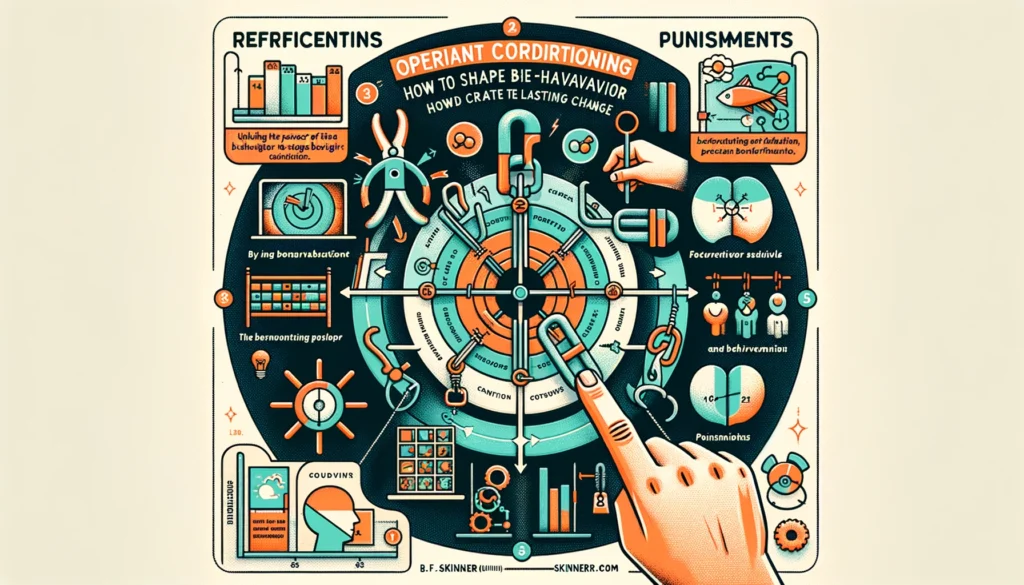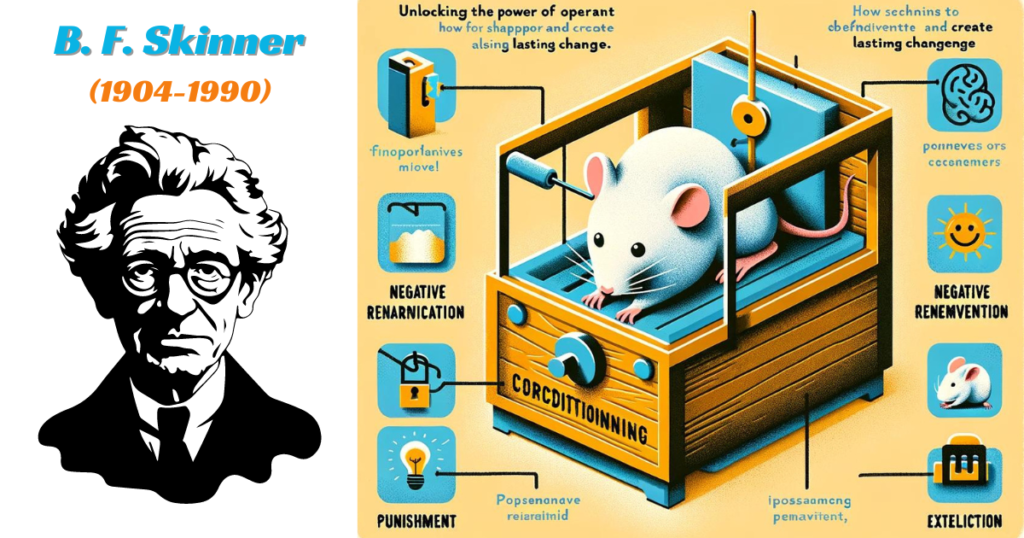In the quest for personal growth and professional development, we often find ourselves facing the same hurdles again and again. We set goals, make plans, but struggle to stick to them. What if there was a way to break this cycle and create lasting change? Enter operant conditioning, a powerful psychological concept that has the potential to transform our behaviors and unlock our true potential.
By understanding the principles of operant conditioning, we can learn how to shape our own behavior and that of others. Whether it’s overcoming a bad habit, improving productivity, or enhancing performance, this methodology offers a structured approach to achieving desired outcomes. By combining positive reinforcement, negative reinforcement, and punishment, we can create an environment that encourages the behaviors we want and discourages those we don’t.
Join us as we explore the depths of operant conditioning and explore practical strategies to effectively shape behavior. Discover the tools and techniques to not only make changes but to make them stick. Get ready to unlock the power of operant conditioning and take control of your behavior to create the lasting change you desire.

Understanding Operant Conditioning
Operant conditioning was first described by behaviorist B.F. Skinner, which is why you may occasionally hear it referred to as Skinnerian conditioning.
Operant conditioning is like a secret tool for changing how we act. It’s all about learning from what happens after we do something. Imagine if every time you cleaned your room, you got a cookie. Soon, you’d start cleaning your room more often because you’d want more cookies. That’s operant conditioning at work. It helps us understand how rewards and consequences shape our actions.
In simple terms, operant conditioning means that our future behavior is influenced by the outcomes of our past behavior. If the outcome is good, we’re likely to do it again. If it’s bad, we might think twice. This method is used all the time, not just with people, but with animals too. Trainers use it to teach dogs new tricks or to get dolphins to jump through hoops.
The Principles of Operant Conditioning
Operant conditioning is built on a few key ideas: positive reinforcement, negative reinforcement, punishment, and extinction.
- Positive Reinforcement: This is about adding something nice to increase a behavior. Like getting a star sticker for every homework assignment you finish. The sticker is a small reward that makes you want to do your homework again.
- Negative Reinforcement: This sounds confusing, but it’s just taking away something annoying or bad to increase a good behavior. For example, if you do your chores, maybe you don’t have to do dishes for a week. The relief of not doing dishes makes you more likely to keep doing your chores.
- Punishment: This involves adding something unpleasant after a behavior to decrease that behavior. If you shout in class and lose recess time because of it, you’re less likely to shout again. The loss of recess is the punishment.
- Extinction: This happens when a behavior stops because it’s no longer followed by a reward. If you used to get cookies for cleaning your room but that stops, you might not be as eager to clean up anymore. The behavior (cleaning) might fade away because the reward (cookies) is gone.
Understanding these principles helps us see why we act the way we do and how we can change. By using rewards and consequences smartly, we can start to shape our behavior in positive ways. Want to exercise more? Reward yourself for each workout. Trying to cut down on junk food? Maybe there’s a consequence for breaking your eating plan, like extra exercise.
Operant conditioning isn’t just about changing behaviors on the surface. It’s about making those changes last. The trick is to use these principles in a way that feels rewarding and not like we’re forcing ourselves. That way, the changes we make are more likely to stick, leading to real, lasting transformation in our habits and behaviors.
Applications of Operant Conditioning in Real-life Situations
Operant conditioning is a powerful method used to teach new behaviors and change existing ones. It’s used in many areas of our lives without us even noticing. Here are some real-life examples:
- Education: Teachers use rewards to encourage good behavior and learning. For example, giving students stickers or praise for completing their homework on time helps them associate positive outcomes with their efforts, encouraging them to keep it up.
- Parenting: Parents use operant conditioning by setting rules and giving consequences. If a child cleans their room, they might get extra playtime. This teaches the child that good actions lead to positive rewards.
- Workplace: Employers use bonuses, promotions, and recognition to motivate employees. When employees know that hard work leads to rewards, they’re more likely to perform well.
- Pet Training: Trainers use treats and praise to teach pets new tricks or good behavior. When a dog sits on command and receives a treat, it learns that following commands leads to good things.
- Health and Fitness: People use rewards to stick to their exercise routines or diets. For example, treating yourself to a movie after a week of workouts can motivate you to keep going.
The Role of Reinforcement in Shaping Behavior
Reinforcement is a key concept in operant conditioning. It’s about using rewards or consequences to make a behavior more or less likely to happen again. Here are the main types:
- Positive Reinforcement: This involves giving something pleasant or desirable right after a behavior occurs, which makes that behavior more likely to happen again. For example, giving a child a treat for doing their homework.
- Negative Reinforcement: This is a bit tricky to understand because it involves removing something unpleasant when a desired behavior occurs, which also makes the behavior more likely to happen again. For instance, turning off a loud alarm when you get out of bed in the morning.
- Punishment: This technique is about adding something unpleasant after a behavior, which makes that behavior less likely to happen again. For example, getting a fine for speeding.
- Extinction: This happens when a behavior that used to get reinforced no longer does, and over time, the behavior happens less often or stops altogether. Imagine if you stop getting likes on your social media posts; you might post less often.
All types of reinforcement are powerful tools for shaping behavior. They help individuals learn what actions lead to positive outcomes and which ones to avoid. By understanding and applying reinforcement, we can encourage good habits and discourage unwanted ones, leading to lasting change.
1. The Power of Positive Reinforcement in Shaping Behavior
Positive reinforcement is a powerful tool for shaping behavior because it focuses on rewarding good behavior instead of punishing bad behavior. This approach is effective for several reasons:
- Increases Motivation: When people know they’ll get something good for doing something right, they’re more motivated to do it.
- Builds Positive Relationships: It helps build positive relationships between people (like parents and children or teachers and students) because it’s based on giving rewards and praise.
- Encourages Repetition of Good Behavior: By rewarding a behavior, you make it more likely that the behavior will be repeated in the future.
- Positive Environment: It creates a more positive and supportive environment, which can be more conducive to learning and growth.
In basic terms, positive reinforcement is about noticing and rewarding the things we want to see more of. It’s a kind and effective way to teach and encourage behaviors that are good for individuals and for society. By using positive reinforcement, we can shape behavior in a way that is both powerful and positive, creating lasting change over time.
2. Using Punishment Effectively in Operant Conditioning
Punishment is when something is done to reduce a behavior. It’s important to use punishment carefully to make sure it works well. Here are some tips:
- Be Specific and Immediate: Punishment should happen right after the behavior you want to change. This helps the person or animal make a clear connection between what they did and the consequence.
- Be Consistent: Apply the punishment every time the unwanted behavior happens. This consistency helps in learning that the behavior is always unacceptable.
- Combine with Positive Reinforcement: While punishment can stop bad behaviors, it’s also important to encourage good behaviors. This means rewarding the behaviors you want to see more of.
- Keep It Proportionate: The punishment should match the behavior in severity. Too harsh punishment can cause fear or aggression, while too light may not work.
- Explain and Educate: Especially with children, explain why the behavior is being punished. Understanding the reason behind the punishment can help in learning the right lessons.
Strategies for Implementing Operant Conditioning in Daily Life
Operant conditioning isn’t just for classrooms or experiments; it can be used every day. Here’s how:
- Set Clear Goals: Know the behavior you want to change. Be clear about what this looks like so you can recognize progress.
- Start Small: Break down your goal into smaller steps. Reward progress towards these smaller goals to keep motivation high.
- Use a Variety of Rewards: Not all rewards need to be things or treats. Praise, extra playtime, or a favorite activity can also be effective rewards.
- Track Progress: Keep a record of the behaviors you’re trying to change and how they’re developing over time. This can help you adjust your approach if needed.
- Be Patient: Change takes time. It’s important to stay patient and consistent, even if progress seems slow.
Operant conditioning is a powerful tool for shaping behavior and creating lasting change. By understanding how to use punishment effectively and applying operant conditioning strategies in daily life, we can improve our habits, teach new skills, and foster positive behavior in ourselves and those around us. With patience and consistency, the principles of operant conditioning can help us achieve our goals and lead to meaningful change.
Overcoming Challenges and Setbacks in Shaping Behavior
When we try to change behavior using operant conditioning, we might face some challenges and setbacks. These can happen for many reasons, like not giving the right rewards, giving them at the wrong time, or the person or animal not understanding what behavior we’re trying to encourage.
1. Be Patient: Change takes time. If you’re not seeing immediate results, it doesn’t mean it’s not working. Keep trying and be patient.
2. Adjust Your Approach: If something isn’t working, try something different. This might mean changing the reward, how often you give the reward, or making the behavior you want to see more clear.
3. Keep it Positive: Focus on rewarding good behavior instead of punishing bad behavior. This makes the learning process more enjoyable and effective.
4. Small Steps: Break down the behavior you want to see into smaller steps. Reward each small step towards the final goal. This helps make big changes feel more manageable.
5. Stay Consistent: Make sure you’re consistent with your rewards. If you’re trying to teach a new behavior, reward it every time it happens. This helps make the connection between the behavior and the reward stronger.
6. Learn from Setbacks: If you face a setback, try to understand why it happened. Use this knowledge to adjust your approach and try again.
Conclusion: Harnessing the Power of Operant Conditioning for Lasting Behavioral Change
Operant conditioning is a powerful tool for shaping behavior and creating lasting change. By understanding how rewards and punishments influence behavior, we can encourage the behaviors we want to see more of. Remember, the key is to be patient, stay positive, and adjust your approach as needed. By overcoming challenges and setbacks with a thoughtful strategy, we can use operant conditioning to make meaningful and lasting changes in behavior. Whether it’s teaching a pet new tricks, helping a child develop good habits, or changing our own behaviors, operant conditioning can help us achieve our goals.
References
- American Psychiatric Association (n.d.). What is obsessive-compulsive disorder? Retrieved January 26, 2020, from https://www.psychiatry.org/patients-families/ocd/what-is-obsessive-compulsive-disorder
- Kumar, D., Sinha, N., Dutta, A., & Lahiri, U. (2019). Virtual reality-based balance training system augmented with operant conditioning paradigm. BioMedical Engineering OnLine, 18, 90.
- PsychCore (2016, October 28). Operant conditioning continued [Video]. YouTube. https://youtu.be/_JDalbCTpVc
- Schunk, D. (2016). Learning theories: An educational perspective. Pearson.
- Skinner, B.F. (1991). The behavior of organisms: An experimental analysis. Copley.
- Skinner, B.F. (1953). Science and human behavior. Macmillan.



Pingback: Lets explain the Operant Conditioning In Psychology: B.F. Skinner Theory -
Hi there! This blog post could not be written any better!
Reading through this post reminds me of my previous roommate!
He continually kept preaching about this. I’ll send this post
to him. Pretty sure he’s going to have a great read. I appreciate you for sharing!
Hello! Thank you so much for your kind words and for sharing your experience. It’s truly heartwarming to hear how much this post resonated with you and reminded you of your time with your former roommate. I’m thrilled to know it struck a chord and that you think it’ll make a great read for him too. I appreciate you taking the time to share this post and for your support. It means a lot to me. Looking forward to hearing more from you in the future!
Can you be more specific about the content of your article? After reading it, I still have some doubts. Hope you can help me.
Indeed, I’d be happy to clarify any doubts you have. Please specify which sections or topics in the article were unclear. I’ll make a follow-up blog post to address your questions and share the link for more clarification.
Can you be more specific about the content of your article? After reading it, I still have some doubts. Hope you can help me.
Thank you for your interest, please feel free to ask your question—I’m here to help and looking forward to our conversation.
Your point of view caught my eye and was very interesting. Thanks. I have a question for you.
Your article helped me a lot, is there any more related content? Thanks!